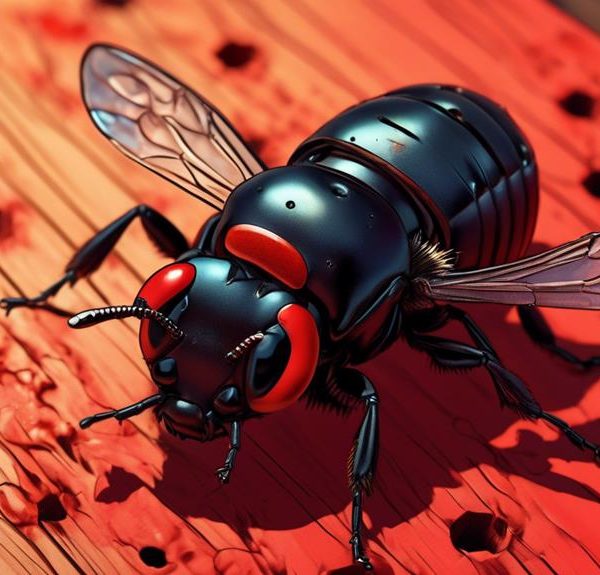Pondering whether male carpenter bees bite? Uncover the surprising truth and their unique defense mechanisms in this fascinating exploration.
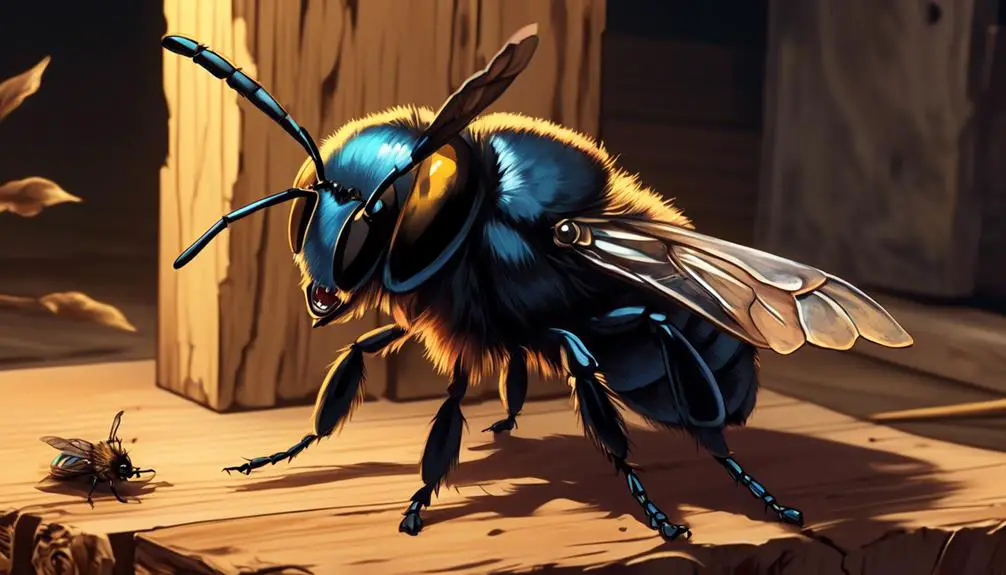
Do Male Carpenter Bees Bite
Have you ever wondered if male carpenter bees bite? As you delve into the world of these buzzing creatures, it's natural to question their behavior and potential hazards they may pose.
Contrary to popular belief, male carpenter bees can't bite as they lack a stinger. However, that's not to say they're entirely harmless. The males have their own unique way of defending themselves which is equally fascinating.
Let's explore this further to get a complete understanding of these intriguing insects.
Key Takeaways
- Male carpenter bees do not possess stingers and are harmless.
- Male carpenter bees may display aggression as a bluff to scare off threats.
- Female carpenter bees can bite with their stingers if provoked or threatened.
- Female carpenter bees are typically non-aggressive and prefer to retreat rather than bite.
Understanding Carpenter Bees
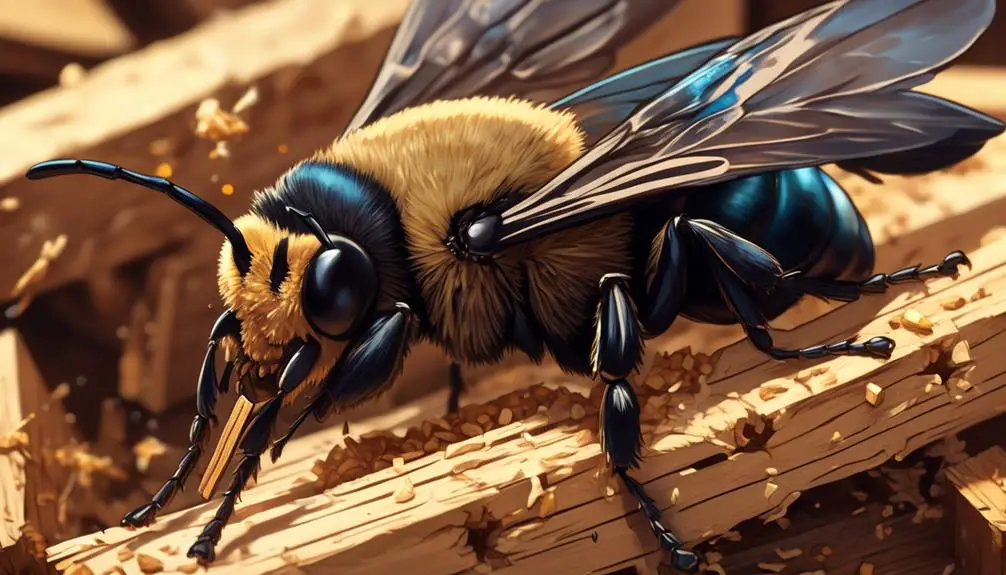
To fully grasp the nature of carpenter bees, you need to delve into their unique characteristics, behaviors, and their impact on the environment. Unlike honey bees, carpenter bees are solitary creatures. They don't form colonies but rather, each female bee takes responsibility for her own nest. Their name stems from their nesting behavior. They're known for boring into wood, creating tunnels for rearing their offspring.
You'll find carpenter bees across the globe, with about 500 species in existence. They're robust, usually larger than other bees, and have a shiny, hairless abdomen. Despite their intimidating appearance, male carpenter bees are harmless. They don't possess stingers. Females, however, can sting but rarely do unless provoked.
Ecologically, carpenter bees are essential. They're prolific pollinators, aiding in the reproduction of numerous plant species. This not only enhances biodiversity but also contributes to food security by aiding crop production. However, their wood-boring habits can cause structural damage, raising concerns for homeowners. Thus, understanding carpenter bees involves acknowledging both their ecological significance and their potential as pests.
Male Vs Female Carpenter Bees

While appreciating their ecological significance and potential harm, it's also vital to understand the distinct differences between male and female carpenter bees, especially concerning their behavior and physical attributes.
You might find it interesting that male and female carpenter bees differ significantly in physical appearance. Females are entirely black, while males have a yellow face and a black body. This color distinction is a crucial factor in identification.
Behaviorally, males are more aggressive but ironically, they're harmless! They don't possess a stinger and hence, can't sting. They hover around nest entrances, warding off intruders. Conversely, female carpenter bees are equipped with a stinger but are less aggressive. They're the ones who drill into wood to create nest tunnels, presenting potential property damage.
In terms of life cycle, females play a significant role. After mating, they lay eggs in the nests they've created, provision them with a food source, and seal off the chamber. Males, on the other hand, die shortly after mating.
Understanding these distinctions not only helps in identifying these creatures but also in implementing effective control measures. Remember, it's the females causing actual damage, not the harmless, yet assertive males.
Aggression Levels in Carpenter Bees
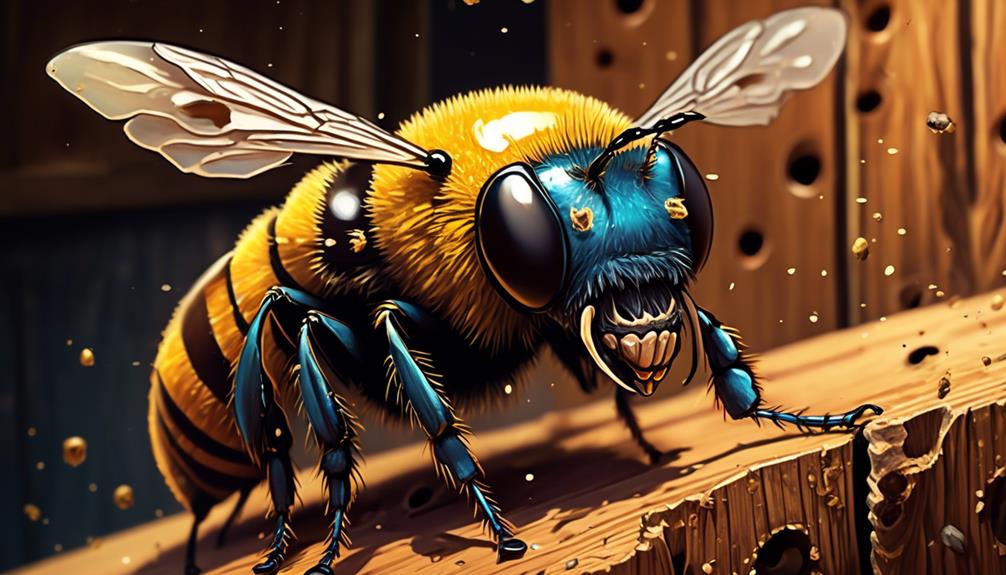
Surprisingly, the aggression levels in carpenter bees are not directly correlated to their potential harm; instead, these behaviors are largely dictated by gender-specific roles and characteristics. Male carpenter bees are more aggressive, often seen darting towards intruders and buzzing around their territories. However, they're also toothless and can't sting.
In contrast, females are less aggressive, but they possess stingers and can inflict a painful bite if threatened. They're typically involved in nest-building and raising offspring, so they exhibit defensive aggression when their nests are disturbed.
To help you understand better, let's look at the table below:
Bee Gender | Aggression Level | Potential Harm |
|---|---|---|
Male | High | Low |
Female | Low | High |
This intriguing dynamic between aggression levels and potential to cause harm in carpenter bees is an interesting angle in the study of their behavior. It's fascinating how gender roles influence their aggression levels and the actual danger they pose. Understanding these nuances can help in managing your interactions with these creatures and in appreciating the complexity of their behaviors.
Do Carpenter Bees Bite?
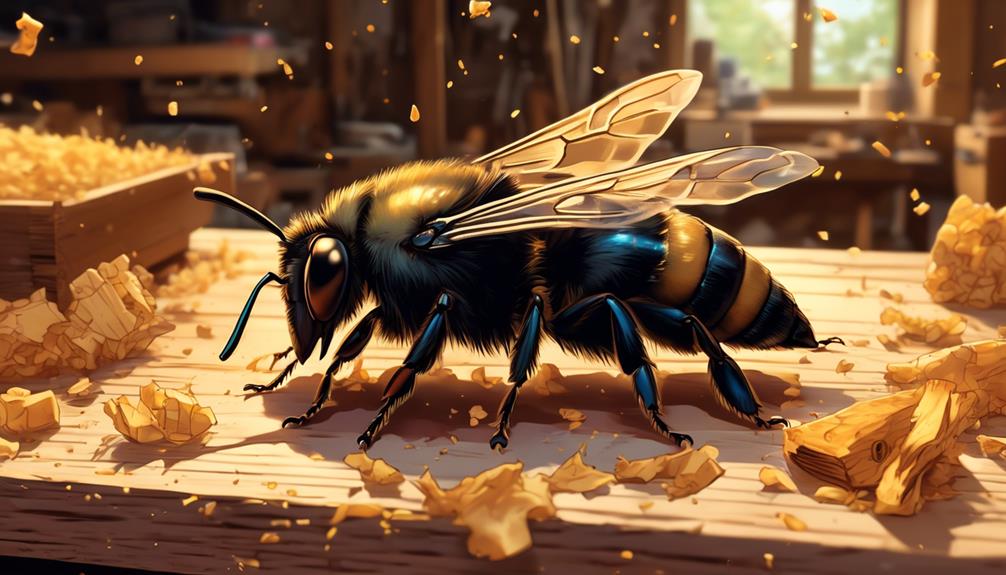
Building on the understanding of gender roles in aggression among carpenter bees, you may now wonder, do these insects actually bite? The simple answer is: they can, but they don't usually.
Allow me to elaborate. Female carpenter bees, unlike their male counterparts, are equipped with a stinger. This stinger can inflict a painful bite if the bee feels threatened or cornered. However, it's important to note that these insects are typically non-aggressive and would rather retreat than resort to biting. They're more likely to use their stinger when protecting their nests.
Male carpenter bees, on the other hand, don't have a stinger. While they can be territorial and may fly towards you if you approach their nests, they're actually harmless. Their aggressive behavior is more of a bluff intended to scare off potential threats.
Safeguard Measures Against Carpenter Bees
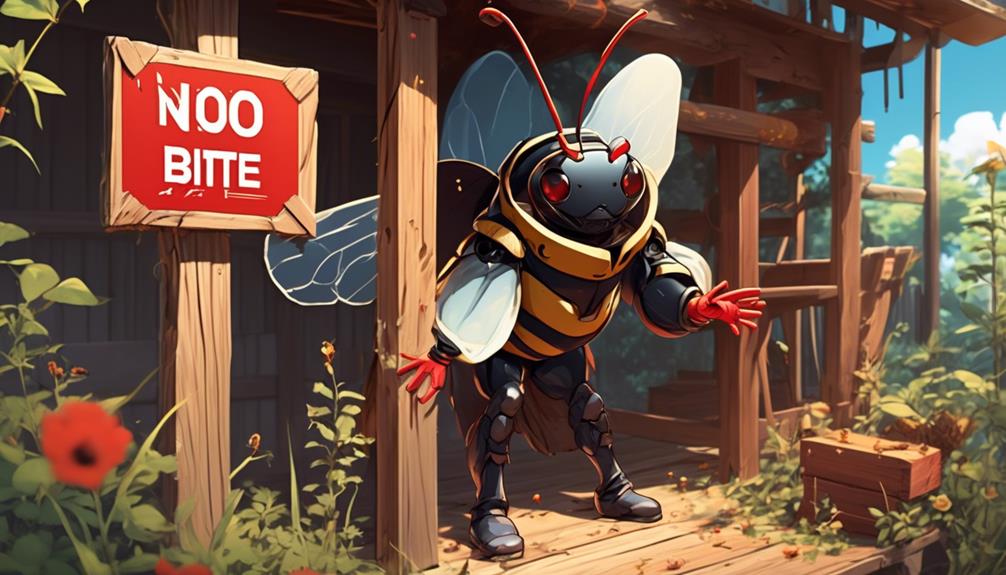
Despite the relatively low risk of bites from carpenter bees, it's crucial that you take necessary precautions to protect your home and surroundings from potential damage caused by these insects. Carpenter bees, while not typically aggressive, are notorious for burrowing into wooden structures to nest, which can lead to structural damage over time.
Firstly, keep an eye out for signs of their presence. Look for perfectly circular holes in wood and a surrounding presence of sawdust. If you spot these signs, it's probable you're dealing with a carpenter bee infestation.
Next, consider professional pest control if the infestation is severe. Experts have the knowledge and tools to effectively eliminate these pests without causing further harm to your property.
However, if the infestation is minimal, DIY methods can be useful. Carpenter bee traps, which mimic the bees' natural nesting sites, can be effective. Likewise, treating the wood with certain repellents can deter the bees from nesting.
Lastly, preventative maintenance is key. Regularly inspect and maintain wooden structures in your property. Using hardwoods, painting or staining wood can also deter these bees. Remember, it's cheaper and easier to prevent an infestation than to deal with its aftermath.
Conclusion
So, you've learned that male carpenter bees, despite their intimidating appearance, don't actually bite. Female carpenter bees can, but they're not likely to unless threatened. Their aggression levels are generally low, making them less of a threat than you might've thought.
However, you still need to safeguard your property against potential damages from their nesting habits. In the end, understanding these amazing creatures can help coexist with them while also protecting your home.


